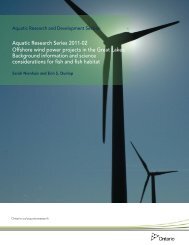Ontario's Natural Heritage Areas - Ministry of Natural Resources
Ontario's Natural Heritage Areas - Ministry of Natural Resources
Ontario's Natural Heritage Areas - Ministry of Natural Resources
You also want an ePaper? Increase the reach of your titles
YUMPU automatically turns print PDFs into web optimized ePapers that Google loves.
• Sets out the obligations <strong>of</strong> a country to regularly<br />
report on the condition <strong>of</strong> the sites.<br />
• Encourages countries to increase public<br />
appreciation <strong>of</strong> the sites.<br />
Selection Criteria<br />
The criteria for the inclusion <strong>of</strong> a site on the World<br />
<strong>Heritage</strong> List are described in the Operational<br />
Guidelines for the Implementation <strong>of</strong> the World<br />
<strong>Heritage</strong> Convention (UNESCO, 2005a). The criteria<br />
have been revised regularly by the World <strong>Heritage</strong><br />
Committee to match the evolution <strong>of</strong> the world<br />
heritage concept itself. A property has outstanding<br />
universal value when the site:<br />
1. Represents a masterpiece <strong>of</strong> human creative<br />
genius.<br />
2. Exhibits an important interchange <strong>of</strong> human values<br />
over a span <strong>of</strong> time or within a cultural area <strong>of</strong><br />
the world, on developments in architecture or<br />
technology, monumental arts, town planning, or<br />
landscape design.<br />
3. Bears a unique or at least exceptional testimony<br />
to a cultural tradition or to a civilization that is<br />
living or has disappeared.<br />
4. Is an outstanding example <strong>of</strong> a type <strong>of</strong> building<br />
or architectural or technological ensemble, or<br />
landscape that illustrates a significant stage or<br />
significant stages in human history.<br />
5. Is an outstanding example <strong>of</strong> a traditional<br />
human settlement, land-use, or sea-use which is<br />
representative <strong>of</strong> a culture or cultures, or human<br />
interaction with the environment especially when<br />
it has become vulnerable under the impact <strong>of</strong><br />
irreversible change.<br />
6. Is directly or tangibly associated with events or<br />
living traditions, with ideas or beliefs, or with<br />
artistic and literary works <strong>of</strong> outstanding universal<br />
significance (a criterion used only in exceptional<br />
circumstances, or together with other criteria).<br />
7. Contains superlative natural phenomena or<br />
areas <strong>of</strong> exceptional natural beauty and aesthetic<br />
importance.<br />
8. Is an outstanding example representing major<br />
stages <strong>of</strong> the Earth’s history, including the record<br />
<strong>of</strong> life, significant ongoing geological processes<br />
in the development <strong>of</strong> landforms, or significant<br />
geomorphic or physiographic features.<br />
9. Represents an outstanding example <strong>of</strong> significant<br />
ongoing ecological and biological processes in<br />
the evolution and development <strong>of</strong> terrestrial,<br />
fresh water, coastal and marine ecosystems, and<br />
communities <strong>of</strong> plants and animals.<br />
10. Contains the most important and significant<br />
natural habitats for in-situ conservation <strong>of</strong><br />
biological diversity, including those containing<br />
threatened species <strong>of</strong> outstanding universal value<br />
from the point <strong>of</strong> view <strong>of</strong> science or conservation<br />
(UNESCO, 2005a:20).<br />
Properties nominated under the first six criteria must<br />
meet the condition <strong>of</strong> authenticity, which is the truthful<br />
and credible expression <strong>of</strong> cultural value through a<br />
variety <strong>of</strong> attributes including:<br />
• Form and design.<br />
• Materials and substance.<br />
• Use and function.<br />
• Traditions, techniques, and management systems.<br />
• Location and setting.<br />
• Language and other forms <strong>of</strong> intangible heritage.<br />
• Spirit and feeling.<br />
• Other internal and external factors (UNESCO,<br />
2005a:21).<br />
All properties must meet the conditions <strong>of</strong> integrity<br />
defined as “a measure <strong>of</strong> the wholeness and<br />
intactness <strong>of</strong> the natural and/or cultural heritage and<br />
its attributes” (UNESCO, 2005a). Each property is<br />
assessed to determine the extent to which it:<br />
• Includes all elements necessary to express its<br />
outstanding universal value.<br />
• Is <strong>of</strong> adequate size to ensure the complete<br />
representation <strong>of</strong> the features and processes<br />
which convey the property’s significance.<br />
• Suffers from adverse effects <strong>of</strong> development and/<br />
or neglect (UNESCO, 2005a:22).<br />
The application for a site to be inscribed on the World<br />
<strong>Heritage</strong> List must come from the country itself.<br />
UNESCO makes no recommendations for listing. The<br />
application must include a plan describing how the<br />
site is and will be managed and protected. The World<br />
<strong>Heritage</strong> Committee meets once a year to review<br />
nominated sites on the basis <strong>of</strong> technical evaluations.<br />
These independent evaluations <strong>of</strong> proposed cultural<br />
and natural sites are provided by two advisory<br />
bodies, the International Council on Monuments and<br />
107 Ontario’s <strong>Natural</strong> <strong>Heritage</strong> <strong>Areas</strong>

















